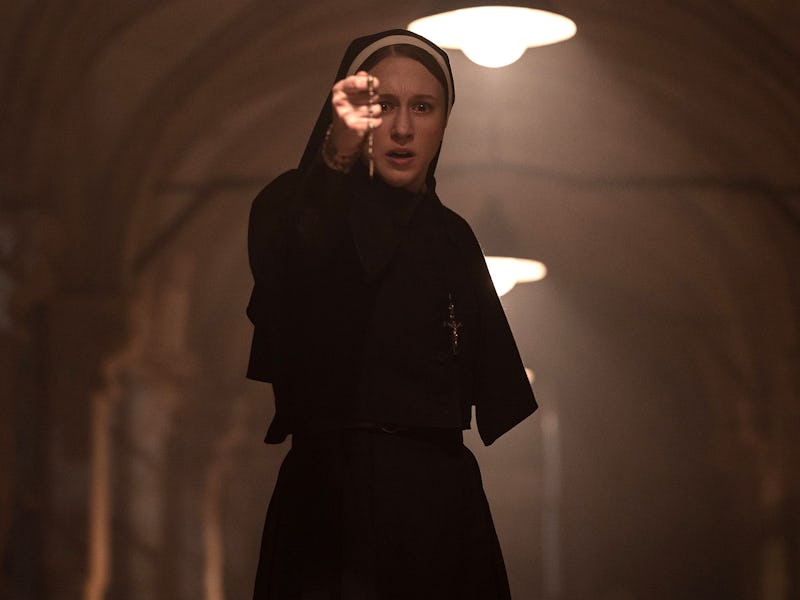The Nun II Gets Back in the Habit of Making Entertaining, If Uneven, Conjuring Films
The much-improved sequel is proof that there’s still life in The Conjuring-verse.

The Conjuring Universe is a pretty strange one in terms of consistency. For each series high, you get an equally passionate low, and 2018’s The Nun was one of those lows. There are a few different reasons why this is, but perhaps its biggest sin is that it was just dull. Mostly reliant on jump scares to keep viewers invested, it was certainly a movie that came out, and that’s all one could really say about it.
You can call its sequel, The Nun II, many things, but dull won’t be one of them. The Michael Chaves-directed sequel is a messy but entertaining one that finally seems to justify this sub-franchise’s existence.
The first film’s lead, Taissa Farmiga’s Sister Irene, shares the screen with the rebellious younger Sister Debra, played by Storm Reid.
Four years after the events of the first film, Sister Irene (Taissa Farmiga) has taken up residence at a new convent in an attempt to move on. There, she finds herself guiding the rebellious Sister Debra (Storm Reid) on her religious journey. Meanwhile, Irene’s ally, Maurice (Jonas Bloquet), has begun settling down as the groundskeeper of a girls boarding school in France. Unfortunately for everyone, he’s been unwittingly bringing Valak (Bonnie Aarons) along in his travels, having been possessed since the first film’s twist ending.
There is a tension here that weighs far heavier this time compared to its predecessor. Much of this has to do with the fact that the story knows what the series has become, something that most Conjuring movies released after the second mainline installment haven’t. At the same time, it doesn’t lean so far into the more outlandish aspects that it becomes a parody. Even at its most predictable, The Nun II never becomes mean-spirited or over-indulgent in anything other than flashback sequences. The fear and mortality of the characters is undeniable.
This likely can be attributed to Malignant and M3GAN screenwriter Akela Cooper, who drafted the story and co-wrote its script with Ian Goldberg and Richard Naing. The Nun II knows when to throw in a cheap jump scare, with one particular fake-out being cringe-worthy for its awkward pacing and mediocre CGI. However, it also knows when to slowly stretch out a palpable feeling of dread. The latter arguably results in one of the most uniquely harrowing moments in the franchise — let’s just say that you won’t look at a magazine stand the same way again.
The jump scares in The Nun II are vastly improved from the first film.
The thematic element of belief is also far more gripping to follow this time around. Debra’s story arc, for example, revolves around her struggling to believe in the nuns’ teachings, and you can’t really blame her. While her backstory is brief, its context adds a surprising amount of nuance to her characterization. What could have been a contrarian character that eventually finds God becomes someone who actually wants to believe in religious power, but can’t seem to find it. It’s a shame that more of the story didn’t elaborate on Irene and Debra’s relationship, as Farmiga and Reid have great familial chemistry.
It’s also a shame that, despite arguably being the symbol of the franchise, Valak itself seems to be a bit of an afterthought in the film’s proceedings. It would be remiss to not bring up Aarons’ recent lawsuit against Warner Bros. accusing the company of withholding merchandising royalties. While this could be sheer coincidence, the film almost carries itself like it’s treading a thin line in terms of how much Valak’s intimidating form shows up on screen.
The Nun II is far and away an improvement from the original.
The majority of the film’s villainy comes from Bloquet’s double-duty performance. Although he does have a more layered role than what he was given in the first film, he’s bogged down by too many possession cliches for it to make an impact. His version of Valak feels like almost any other demon-possessed villain, which feels contradictory to what makes it such an iconic character for the franchise — the reason why it is disturbing is because of how it’s able to withstand and even feed off of protective religious imagery, so swapping that out for Just Some Guy is underwhelming.
All of that being said, it’s not a bad film by any stretch of the means. The cinematography by Tristan Nyby helps emphasize Valak’s true proximity to our protagonists, especially when paired up with Stéphane Cressend’s creepy and lived-in production designs. Marco Beltrami’s score is also great in both its dread and smile-inducing moments.
While sometimes uneven in its scares, The Nun II makes up for it by being a genuinely compelling story with great visuals and an empathetic thoroughline. It shows glimmers of what The Conjuring Universe could be like if making it the MCU of horror wasn’t its primary focus: somewhat self-contained and thought-provoking stories on the very concept of belief. If this was the case, maybe it wouldn’t be such a surprise how much better this sequel was to its predecessor.